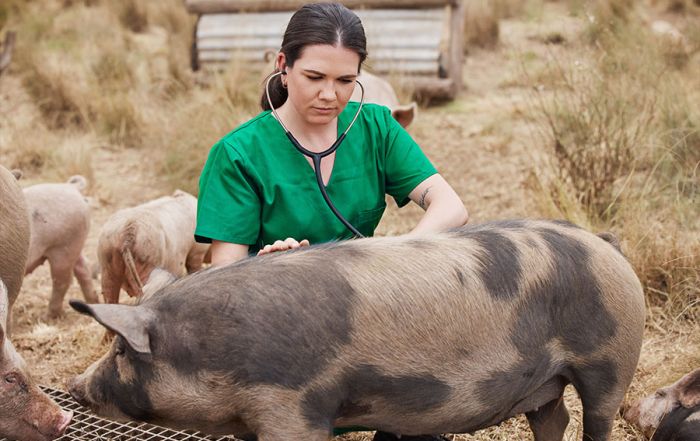Produce Safety: A Growing Concern
Fifteen to 20 years ago, if you would have asked a restaurant manager about food safety, she or he would have likely engaged you in a deep conversation about end-point cooking temperatures of meat and poultry products, limiting cross contamination, and the temperature danger zone. Missing from the conversation would have been much, if any, discussion about fresh produce safety. Then, we didn’t think anyone could get sick from lettuce or tomatoes. Then in 2006 – we had the BIG bagged lettuce national outbreak followed by outbreaks of listeria and salmonella from cantaloupes in 2011 and 2012. Now, we know better.
Fast forward to 2020 and attention to produce safety is something of which foodservice operations are very mindful. Produce-related outbreaks account for around half of all foodborne illness outbreaks (1), whereas in the 1970s, they accounted for a mere 0.7% of all outbreaks, and only 6% in the 1990s (2).
Sprouts, salad mixtures, leafy greens, melons, tomatoes, and berries (3) have been implicated in the most outbreaks of foodborne illness. It is likely that one or more of these food items is used in your operation. So to protect your customers, it is vital that solid standard operating procedures are in place to guide practices for the purchase, receiving, storage, and service of these items.
In our May SafeBites webinar, Dr. Angela Shaw, an Associate Professor with Iowa State University Extension and Outreach, addressed all of these matters in addition to the back story about safe practices on the farm. She provided a great overview about the Food Safety Modernization Act and its Produce Safety Rule and how to work with local farms if you are bringing in fresh, local produce. It is well worth the hour investment in watching it (and CEU’s are available!).
Here is a brief recap of the important control steps as fresh produce flows through a foodservice:
When purchasing, make sure you are purchasing from a reputable supplier. What does that mean? Many operations use national suppliers or regional distributors, most of whom have trace back programs and requirements for their sources of products. Most of their suppliers are either GAPs Certified (a third-party safety assurance program) or meet requirements of the Produce Safety Rule related to water testing, use of biological soil amendments, worker training, and facilities and equipment. However, most smaller size operations that sell directly to retailers or consumers, are not required to meet these standards. Therefore, you must conduct your own due diligence and make sure that your local grower follows preventative control measures. Many foodservice managers purchase locally as a way of supporting the local economy, but safety is still important. To protect you and your operation, it may mean you will have to work with your local farmer to help them understand your needs and requirements. We advise clear communication to any produce vendor with written specifications that identify what is wanted (and remember with each produce item there are varieties!), how much, how it should be packaged (materials should be food contact and protect the product), and conditions of delivery (when, temperature, etc.).
When receiving, make sure the individual you have designated to receive knows which suppliers you are accepting orders from, when it is acceptable to receive foods, and organizational expectations which are based on those written specifications. Receiving is a check that the quality and quantity of what is delivered matches the order. It is not practical, or even possible, to inspect every single produce item but random checks of bulk units (if layered in a case, spot check second or third layers) are doable. Also, check the temperature. We all know that the food code has identified certain produce items as temperature controlled for safety or TCS. These include raw seed sprouts, cut melons, cut leafy greens, and cut tomatoes or mixtures of cut tomatoes. TCS foods should all be received at 41°F or below. This means that the ready-to-eat or convenience forms of fresh produce that are purchased should be kept at refrigerated levels during transit and when received. For non-processed, whole fresh produce, correct temperatures and humidity levels will maintain freshness. With these products, be sure to check for insect damage, or evidence of disease or bruising.
Operators generally want to serve fresh produce, not stored produce, but with deliveries occurring once a week or so, it is necessary to store produce onsite before use. As mentioned, be mindful of temperature and humidity as both can impact the shelf life of the produce. While many produce items do well at 32°F, some are cold sensitive and may require a higher temperature. For example, bananas prefer temperatures between 56°F to 58°F and potatoes prefer temperatures between 45°F to 68°F. Cathy once put fresh basil (a cold sensitive herb) in the refrigerator and found out the next day that it was black! If you must store fresh produce with other non-produce products, make sure you organize your storage following food code guidelines to avoid cross contamination, for which FoodHandler has developed a great virtual resource. Humidity is another important point that is often not considered by foodservice operators. In areas where the air is dry, a humidifier may be required to ensure maximum shelf life. To check the optimal storage conditions for fruits, vegetables, and herbs that you use, Dr. Shaw suggested looking at resource fact sheets from Cornell University Cooperative Extension or the University of Maine.
When preparing and serving, the same basic rules you have known for years still apply. Be sure employees are cleaning and sanitizing work spaces, inspecting the produce and washing it (all produce, even items with peels) before cutting, washing their hands when and how they should, practicing correct glove use, and maintaining temperature control if preparing excessive amounts of produce over an extended period of time. As with some many steps in the food flow, employee hygiene practices are critical.
A common question relates to preparing pre-cut lettuce and bagged salads and whether there is a need to wash prior to use. If produce is received as “ready-to-eat”, “washed”, or triple washed”, as is the case with most fresh cut lettuce and spinach varieties available for foodservice operations, then the answer is NO! We repeat – they do not need to be washed before use. If any microorganisms survived the commercial washing process, it is highly doubtful that you will reduce the microbial load to a safer level in the foodservice operation – in fact, there is a greater risk of cross contamination during the washing process than if product was used from the bag.
During summer months, fresh produce is widely available and enjoyed by your customers. Food safety across the food chain is not a new concept, but outbreaks of foodborne illnesses have made us more aware of risks, particularly from fresh produce. Taking steps within the foodservice to control these risks is important to be sure safe food is served. Risk Nothing!
- Painter, J. A., Hoekstra, R. M., Ayers, T., Tauxe, R. V., Braden, C. R., Angulo, F. J., & Griffin, P. M. (2013). Attribution of foodborne illnesses, hospitalizations, and deaths to food commodities by using outbreak data, United States, 1998–2008. Emerging infectious diseases, 19(3), 407.
- Sivapalasingam, S., Friedman, C. R., Cohen, L., & Tauxe, R. V. (2004). Fresh produce: A growing cause of outbreaks of foodborne illness in the United States, 1973 through 1997. Journal of food protection, 67(10), 2342-2353.
- Callejón, R. M., Rodriguez-Naranjo, M. I., Ubeda, C., Hornedo-Ortega, R., Garcia-Parrilla, M. C., & Troncoso, A. M. (2015). Reported foodborne outbreaks due to fresh produce in the United States and European Union: Trends and causes. Foodborne pathogens and disease, 12(1), 32-38.
Never Did I Ever…
Yes, I know the real game is “never have I ever”, but that phrase didn’t work [...]
Understanding Food Contamination in Foodservice Operations
Within this blog, I’ve provided a lot of details about the finer points of food safety [...]
The Antibiotic Debate in Our Food Chain
The discovery of antibiotics in medical science is regarded as one of the most important medical [...]
Exposing the Risks of Raw Milk
When I began my career in the food safety area several years ago, I never dreamed [...]









